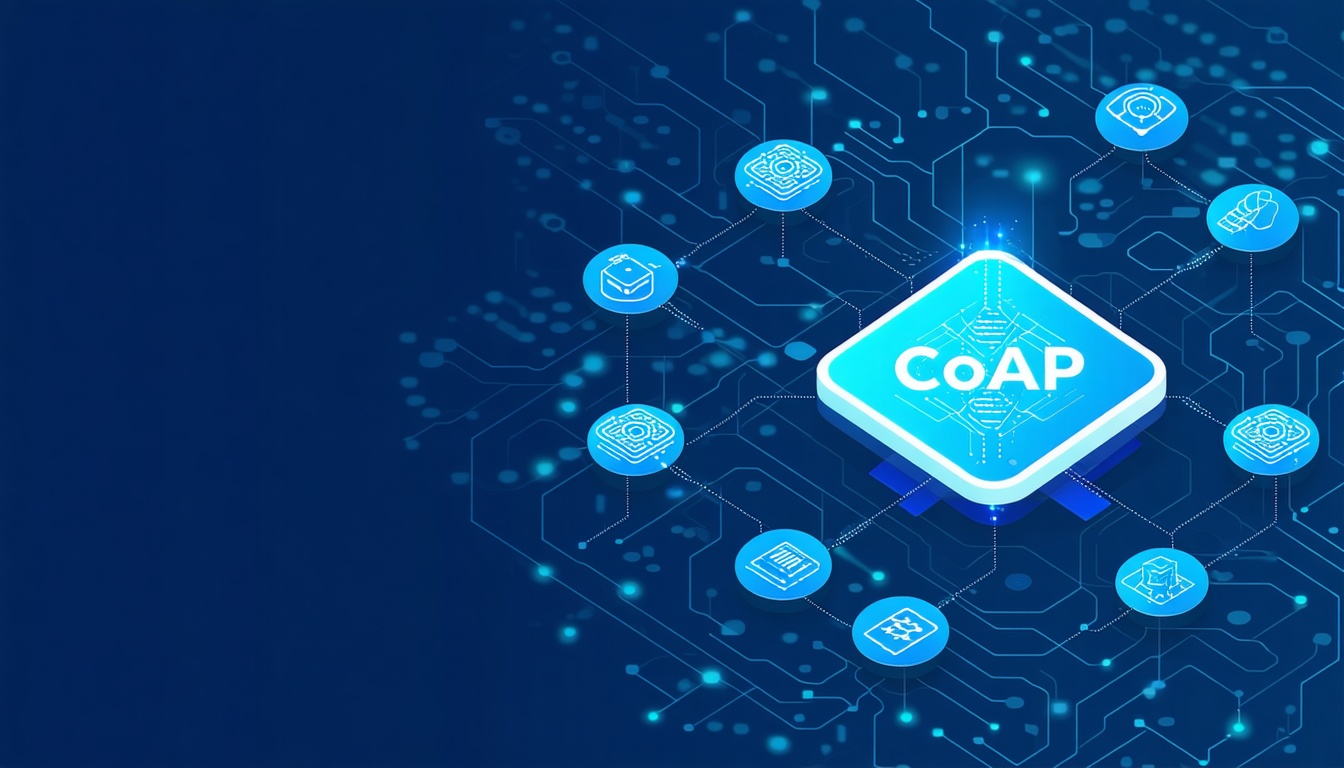This post may contain affiliate links. If you click through and make a purchase, we may earn a commission at no additional cost to you. This helps support our work and allows us to continue providing valuable content. For more information, please see our disclosure policy.

The Internet of Things (IoT) is growing at an astonishing pace. By 2030, analysts expect over 30 billion devices to be connected worldwide, from smart watches and streetlights to industrial sensors and agricultural equipment. Many of these devices are tiny, battery powered and designed to last for years without maintenance.
The challenge? Getting all these devices to communicate reliably without draining their batteries or clogging networks with unnecessary data. Traditional web protocols like HTTP are too heavy for this environment. That’s where the Constrained Application Protocol (CoAP) comes in.
CoAP is a communication standard designed specifically for the IoT era. It’s lightweight, secure and built to handle the realities of constrained devices. Whether it’s a sensor in a factory or a wearable on your wrist, CoAP enables efficient communication that scales to billions of devices.

Why is CoAP Ideal for IoT?
Minimal Resource Footprint
IoT devices often have limited memory and processing power. CoAP was designed with this in mind, running on UDP instead of TCP and using a message header as small as 4 bytes. Compared to HTTP’s much larger overhead, CoAP dramatically reduces the cost of communication.
This results in:
- Reduced bandwidth use: Ideal for cellular, satellite or LPWAN connections
- Extended battery life: Devices transmit less data and most importantly, save power
- Faster responses: Small packets mean lower latency
Take the example of a smart agriculture sensor that transmits soil moisture every hour. It might send 200+ bytes with HTTP. With CoAP, the same reading could take fewer than 50 bytes. Across thousands of sensors, the savings would be enormous.
Familiar RESTful Model
CoAP isn’t completely new territory for developers. It borrows from the REST model of the web, making it easy to understand and use.
- GET: Read data from a sensor
- POST: Trigger an action (e.g., start irrigation)
- PUT: Update a configuration (e.g., change temperature threshold)
- DELETE: Reset or remove stored data
This means web developers can quickly adapt their skills to IoT without learning a brand new paradigm.
Reliability Built for IoT
Because CoAP runs on UDP, it doesn’t force reliability in every situation. Instead, it gives developers flexible options.
- Confirmable (CON) messages: Acknowledged, retransmitted if necessary (best for firmware updates or configuration changes).
- Non-Confirmable (NON) messages: “Send and forget” delivery, suitable for frequent sensor data where a missed reading isn’t critical.
This balance allows networks to stay efficient while ensuring important messages get through.
Designed for Power Saving Devices
Many IoT devices spend most of their lives in low power sleep mode. CoAP readily supports this with features such as:
- Observe: Clients can subscribe to updates, so devices only send data when something changes.
- Separate responses: A server can quickly acknowledge a request and provide the full response later.
This makes CoAP perfect for sensors that wake briefly, send data and return to sleep.
Multicast for Efficiency
Another advantage of CoAP is its multicast support, letting one message reach many devices at once. This is especially useful for:
- Device discovery: Finding all IoT devices of a certain type on a network
- Bulk updates: Sending configuration changes to a group of devices
- Alerts: Broadcasting an emergency message to multiple endpoints simultaneously
How CoAP Architecture Works
CoAP’s design mirrors the web but is optimized for IoT.
Message Layer: Ensures messages are sent and received over UDP, handling reliability through Confirmable, Non-Confirmable, Acknowledgment and Reset types.
Request/Response Layer: Implements RESTful interactions, with response codes similar to HTTP. Examples include 2.05 Content (success), 4.04 Not Found and 5.00 Internal Server Error.
Messages are encoded in a compact binary format to minimize overhead while still carrying tokens, options and payloads.
Security in CoAP
Security is critical for IoT, where devices can often be exposed to hostile networks.
DTLS: Security for UDP
Since CoAP uses UDP, it relies on Datagram Transport Layer Security (DTLS) instead of TLS. DTLS provides:
- Encryption to prevent eavesdropping
- Authentication via certificates or pre-shared keys
- Message integrity checks
- Replay protection to stop attackers resending old packets
OSCORE: Security for Constrained Devices
For very constrained devices, DTLS can still be too heavy. OSCORE (Object Security for Constrained RESTful Environments) provides lightweight, end-to-end security at the application layer, even across proxies and multicast groups.
This ensures data stays secure while minimizing resource use.
CoAP vs HTTPS: Which One Should You Use?
| Aspect | CoAP | HTTPS |
|---|---|---|
| Transport | UDP | TCP |
| Overhead | Very low (4+ bytes header) | Higher (100+ bytes typical) |
| Reliability | Flexible (confirmable or not) | Always reliable |
| Power consumption | Very low | Higher |
| Real-time performance | Excellent | Moderate |
| Ecosystem maturity | Growing in IoT | Very mature on the web |
Use CoAP when:
- Devices need to conserve power
- You’re building large scale sensor networks
- Networks are unreliable or lossy
- Real-time updates are required
Use HTTPS when:
- Integrating with web services and browsers
- Supporting complex, user facing apps
- Leveraging mature development and debugging tools
Implementing CoAP in IoT Projects
Building with CoAP is straightforward, thanks to a range of libraries and platforms. Some of these are listed below:
- Eclipse Californium (Java): Enterprise-ready with security and extensions
- libcoap (C): Widely used in embedded projects with DTLS support
- CoAPthon (Python): Great for prototyping and testing
- node-coap (JavaScript): Ideal for rapid development in Node.js
Best practices include:
- Organizing resources with intuitive URIs (e.g.
/sensors/temperature) - Supporting discovery through
/.well-known/core - Using efficient data formats like CBOR instead of verbose JSON
- Combining confirmable and non-confirmable messages for balance
CoAP and LwM2M: Smarter Device Management
For managing large deployments, CoAP is often paired with Lightweight M2M (LwM2M), an industry standard that adds:
- Device registration and bootstrapping
- Remote configuration and firmware updates
- Diagnostics and monitoring
- Access control and security management
In smart cities, LwM2M can allow thousands of CoAP-enabled streetlights to be monitored, updated and managed from a central dashboard.
Real World Applications of CoAP
CoAP is already widely used in:
- Smart cities: Traffic management, air quality sensors and connected lighting
- Industry: Predictive maintenance and equipment monitoring
- Healthcare: Wearables, connected inhalers and patient monitoring devices
- Agriculture: Soil sensors, irrigation systems and livestock tracking
- Energy: Smart meters and grid management
These applications highlight why CoAP’s mix of low power, low bandwidth and strong security makes it ideal for IoT.
The Future of CoAP
CoAP’s role in IoT is only growing. Notable trends shaping its future include:
- Edge computing: Processing data closer to where it’s generated
- 5G and NB-IoT: Cellular technologies that complement CoAP for massive IoT deployments
- AI and machine learning: Optimizing communication patterns based on network conditions and device behavior
The Little Protocol That Could
The Constrained Application Protocol may be “lightweight” by design, but its impact on IoT is anything but small. By combining the simplicity of REST with the efficiency of UDP, CoAP gives connected devices the ability to talk to each other without draining power or bandwidth. Features like reliability control, multicast messaging and the Observe model make it perfectly suited to the realities of IoT networks, while DTLS and OSCORE keep communications secure, even on constrained hardware.
From smart city streetlights to industrial machines, healthcare wearables to agricultural sensors, CoAP is already proving its value in the real world.

